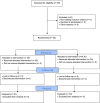Effect of post-isometric relaxation versus myofascial release therapy on pain, functional disability, rom and qol in the management of non-specific neck pain: a randomized controlled trial
- PMID: 35698187
- PMCID: PMC9190112
- DOI: 10.1186/s12891-022-05516-1
Effect of post-isometric relaxation versus myofascial release therapy on pain, functional disability, rom and qol in the management of non-specific neck pain: a randomized controlled trial
Abstract
Background: Non-specific neck pain is the most prevailing musculoskeletal disorder which has a large socioeconomic burden worldwide. It is associated with poor posture and neck strain which may lead to pain and restricted mobility. Physical therapists treat such patients through several means. Post isometric relaxation and Myofascial release therapy are used in clinical practice with little evidence to be firmed appropriately. So, this study was conducted to explore the effect of Post-isometric relaxation in comparison to Myofascial release therapy for patients having non-specific neck pain.
Methodology: Sixty patients were randomly allocated to Post isometric group and the Myofascial group. The treatment period was of 2 weeks. All the patients were evaluated using the Visual analogue scale (VAS), Neck disability index (NDI), Universal Goniometer, and WHO BREF Quality of life-100 in the 1st and 6th sessions. Recorded data was entered on SPSS 21. Data were examined using two-way repeated ANOVA to measure the variance of analysis (group x time).
Results: Analysis of the baseline characteristics revealed that both groups were homogenous in terms of age and gender i.e. a total of 60 participants were included in this research study 30 in each group. Out of 60 patients, there were 20(33.3%) males and 40(66.7%) females with a mean age of 32.4(5.0) years. Participants in the Post Isometric group demonstrated significant improvements (p < 0.025) in VAS, NDI, Cervical Extension, left side rotation ranges, and QoL (Social Domain) at the 2-week follow-up compared with those in the Myofascial group. In addition, the Myofascial group indicated significantly better improvement in the mean score of CROM (flexion and right and left side bending).
Conclusion: The study demonstrated patients with nonspecific neck pain can benefit from the post isometric relaxation with significant improvement in pain, disability, cervical ROM, and Quality of life compared with myofascial release therapy.
Trial registration: Clinical Trial registered on clinicaltrial.gov (NCT number) NCT04638062 , 20/11/2020 (prospectively registered).
Keywords: Isometric Strengthening Exercise; Muscle Energy Technique; Myofascial Release Therapy; Non-Specific Neck Pain; Post Isometric Relaxation.
© 2022. The Author(s).
Conflict of interest statement
No financial and non-financial competing interests.
Figures
References
Publication types
MeSH terms
Associated data
LinkOut - more resources
Full Text Sources
Medical




